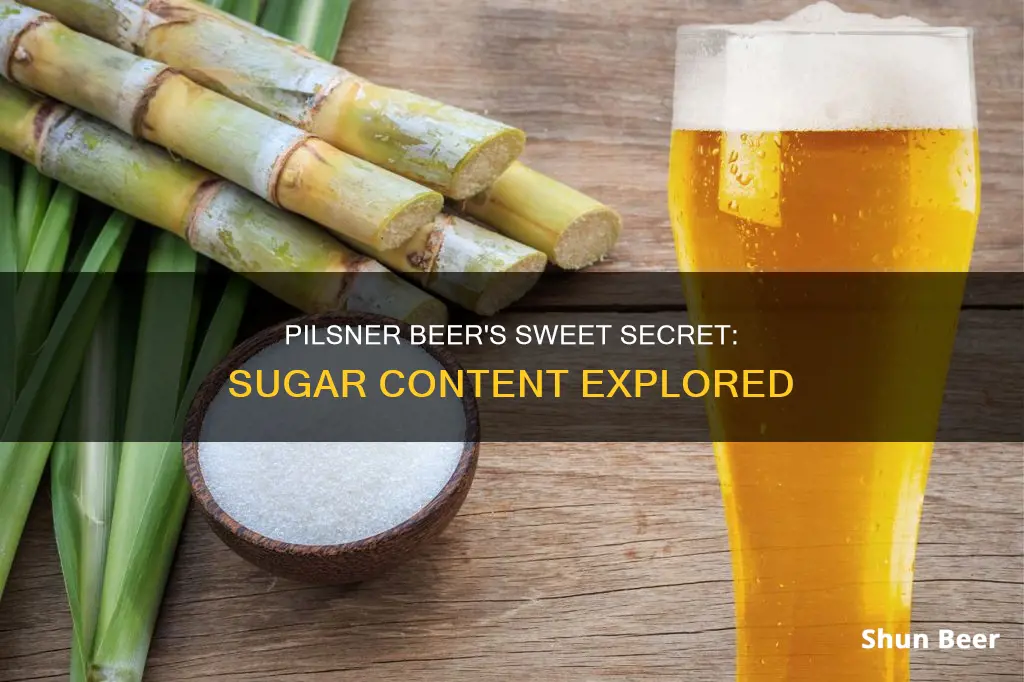
Beer is made from grains, spices, yeast, and water. While sugar is not added to the list, it is necessary to produce alcohol. Pilsner beer, for example, contains carbohydrates, which can raise your blood sugar. However, the amount of sugar in beer depends on the initial gravity and the type of yeast strain used during fermentation. Beer manufacturers may also add other sugar-containing ingredients to their recipes, such as honey and corn syrup, to enhance the flavor of their beer.
What You'll Learn

Pilsner beer is low in sugar
It is a common misconception that beer is loaded with sugar. While sugar is indeed a key element in the beer-brewing process, it is not added as an ingredient. Instead, it comes from the processing of the grains and is then fermented by yeast to produce alcohol. Therefore, aside from non-alcoholic beers, most beers tend to have a low sugar content.
Pilsner beer is a great example of a beer style that is low in sugar. A typical Pilsner beer, such as Beck's, has 0 grams of sugar per can or bottle. This is consistent with other popular Pilsner brands, which generally list their sugar content as 0 grams.
The low sugar content in Pilsner beer is due to the fermentation process, where the yeast converts sugars into alcohol. While the initial stages of brewing involve creating a sugar-containing liquid called wort, the subsequent fermentation step ensures that the final product has minimal sugar remaining.
It is worth noting that while Pilsner beer may be low in sugar, it still contains carbohydrates, which can affect blood sugar levels. Additionally, the alcohol content in beer can also impact blood sugar levels, potentially leading to hypoglycemia or low blood sugar. Therefore, it is generally recommended to consume beer with a carb-containing meal.
In summary, Pilsner beer is typically low in sugar due to the fermentation process. However, it is important to consider the overall carbohydrate and alcohol content when assessing its potential impact on blood sugar levels.
Sugar Quantity for Brewing 40 Pints of Beer
You may want to see also

Sugar is essential in the beer-making process
Sugar is indeed essential to the beer-making process, but it is not added as an ingredient. Instead, it is derived from the grains used, such as barley and wheat, which are soaked, germinated, and dried in the initial malting phase. This process breaks down the stored starches in the grains into fermentable sugars, mainly maltose. The malted grains are then soaked in hot water to create a sugar-containing liquid called wort.
The role of sugar in brewing is crucial as it is the nutrient from which yeast produces alcohol. During fermentation, yeast converts these sugars primarily into alcohol and carbon dioxide, significantly influencing the beer's final sugar content and overall character. While most sugars are converted, the residual sugar that remains gives the beer its distinctive taste and body.
The type of sugar in beer is primarily maltose, a disaccharide made up of two glucose molecules. However, other sugars such as sucrose, fructose, and glucose can also be present, depending on the specific recipe and style of the beer.
The amount of sugar in beer depends on various factors, including the type of yeast and fermentation process, the ingredients used, and the beer style. For example, ales tend to have a higher alcohol content and lower sugar content due to the use of top-fermenting yeast, while lagers often have a slightly higher sugar content due to more residual unfermented sugars.
In summary, while sugar may not be directly added to the beer-making process, it is an essential component that undergoes various transformations to create the final product, contributing to both the alcohol content and the unique flavour profile of each brew.
Starch and Sugar in Beer: What's the Truth?
You may want to see also

Beer contains carbohydrates
The main type of sugar found in beer is maltose, which is a disaccharide made up of two glucose molecules. Other sugars present in beer include maltotriose, glucose, sucrose, and fructose. These sugars are derived from the processing of grains, such as barley and wheat, during the brewing process. While sugar is not added directly to the beer, it is a crucial element in the fermentation process, as yeast ferments sugars into alcohol and carbon dioxide.
The amount of carbohydrates in beer can vary depending on the type and brand. For example, a regular beer typically contains around 12.8 grams of carbohydrates per 12 ounces, while a light beer may have about 5.9 grams. Non-alcoholic beers tend to have the highest carbohydrate content, with 28.5 grams of carbs per 12 ounces.
It is important to note that the sugar content in beer is generally low, as most of the sugar is fermented into alcohol. However, beer manufacturers may add other sugar-containing ingredients, such as honey or corn syrup, to enhance the flavor. Additionally, the presence of carbohydrates in beer contributes to its calorie content, making it a significant source of calories.
In summary, beer contains carbohydrates, which are broken down into sugars during the brewing process and subsequently fermented into alcohol. The specific carbohydrate and sugar content can vary depending on the type and brand of beer, but overall, beer tends to have a low sugar content.
Beer and Blood Sugar: What's the Connection?
You may want to see also

Beer is made from grains, spices, yeast, and water
Grains
The most common grain used in beer is barley, which is often malted. This process involves soaking the grain in water, allowing it to germinate, and then drying it in a kiln. Malting produces enzymes that convert the starches in the grain into fermentable sugars, which the yeast will later consume to produce alcohol. Other grains used in beer include wheat, rice, corn, oats, and rye.
Spices
The principal spice used in beer is hops, which provides a piquant aroma, a variety of flavours, and a bitterness that balances the sweetness of the malt. Hops also have antimicrobial properties, which help to stabilise the beer and keep it fresh for longer.
Yeast
Yeast is a microorganism that metabolises the sugars extracted from grains, producing alcohol and carbon dioxide in the process. There are two main categories of brewing yeast: ale yeast and lager yeast. Ale yeasts tend to have a higher alcohol tolerance than lager yeasts, resulting in ales with higher alcohol content and lower sugar content.
Water
Water is the main ingredient in beer, accounting for over 95% of its composition. The mineral content of the water can vary depending on the region, which can influence the taste of the beer and determine which types of beer are best suited to be brewed there.
The Brewing Process
The process of brewing beer involves malting, mashing, boiling, fermentation, and maturation. During malting, the grain is soaked in water, germinated, and dried. In the mashing stage, the germinated grains are roasted, milled, and soaked in hot water to create a sugar-containing liquid called wort. Hops or other spices are added during the boiling step, and the wort is then cooled and filtrated. Yeast is added during fermentation to convert the sugars into alcohol and carbon dioxide. Finally, the beer is stored and left to age during maturation.
Dark Beer's Sweet Secret: More Sugar, More Flavor?
You may want to see also

Pilsner beer has a low calorie count
Beer contains very little sugar, and the sugar that is present comes from the processing of the grains used in the brewing process, rather than being added directly. Pilsner is a type of beer, and so it generally follows that it will have a low sugar content.
Pilsner beer also has a low calorie count, with one can or bottle of Beck's Pilsner (5% alc.) containing 138 calories. This is relatively low compared to other alcoholic drinks. For example, a typical glass of red wine contains around 150-170 calories.
The low-calorie content of pilsner beer is due in part to its low sugar content, as sugar is a significant source of calories. However, it is worth noting that beer does contain carbohydrates, which can also contribute to calorie intake. Carbohydrates are made up of sugar molecules, and while beer contains a fair amount of carbs, its sugar content is quite low.
The specific calorie content of pilsner beer may vary depending on the brand and the alcohol content. For example, Pilsner Urquell (4.4% alc.) has 156 calories per 12 fl. oz can or bottle. This is slightly higher than the calorie content of Beck's Pilsner, which may be due to a difference in alcohol content or other factors.
Overall, pilsner beer typically has a low calorie count, which is partly due to its low sugar content. However, it is important to consider the contribution of carbohydrates to the overall calorie intake when consuming this beverage.
Draft Beer's Sugar Content: How Sweet is Too Sweet?
You may want to see also
Frequently asked questions
Yes, there is sugar in Pilsner beer. However, the amount of sugar is usually quite low, as most of it is fermented into alcohol during the brewing process.
The sugar content of Pilsner beer can vary depending on the specific brand and brewing process. However, regular beers typically have little to no sugar, while light beers may have slightly more.
Yes, the sugar in Pilsner beer can affect blood sugar levels. Beer contains carbohydrates, which can raise blood sugar levels. Additionally, alcohol can lower blood sugar levels by impairing sugar metabolism.
Sugar is added to Pilsner beer as a source of food for the yeast, which ferments the sugar into alcohol. Additionally, sugar can be added to adjust the alcohol level, lighten the body, add flavor, or prime the beer for carbonation.
Yes, there are alternatives to using sugar in Pilsner beer. Some brewers may use honey, maple syrup, or other natural sweeteners to add flavor and priming capabilities. However, these alternatives should be used in moderation to avoid overpowering the beer's flavor.







